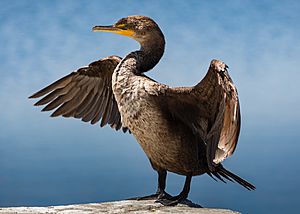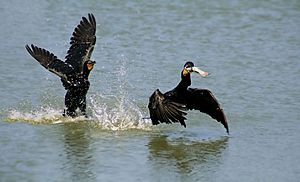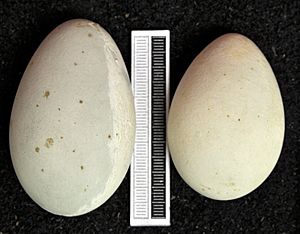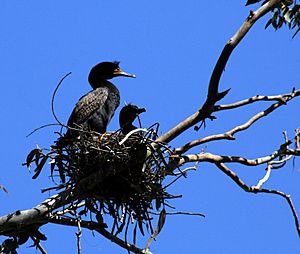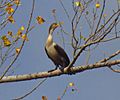Double-crested cormorant facts for kids
Quick facts for kids Double-crested cormorant |
|
|---|---|
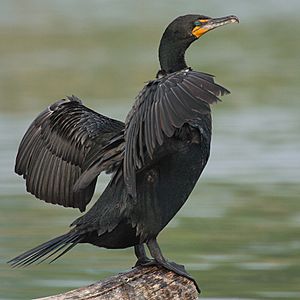 |
|
| Adult in non-breeding plumage | |
| Conservation status | |
| Scientific classification | |
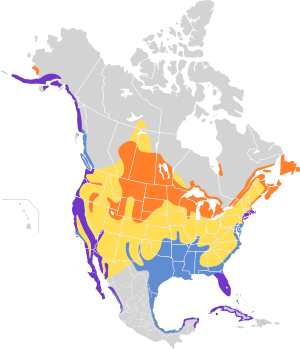 |
|
| Synonyms | |
|
Carbo auritus Lesson, 1831 |
The double-crested cormorant (Phalacrocorax auritus) is a type of water bird that belongs to the cormorant family. You can find these birds near rivers, lakes, and along coastlines. They live all over North America, from the Aleutian Islands in Alaska down to Florida and Mexico.
These birds are about 70–90 cm (28–35 in) long and are completely black. When it's time to breed, they grow a small double crest of black and white feathers on their heads. They also have a patch of orange-yellow skin on their face. There are five different types, or subspecies, of the double-crested cormorant. They mostly eat fish and catch them by swimming and diving underwater.
Like all cormorants, their feathers are not fully waterproof. This means they need to spend time drying their wings after swimming. In the past, their numbers went down because of a chemical called DDT. But luckily, their population has grown a lot in recent years!
Contents
About the Double-Crested Cormorant
What's in a Name?
The double-crested cormorant was first described by René Primevère Lesson in 1831. Its scientific name, Phalacrocorax auritus, comes from old Greek and Latin words.
- Phalacrocorax means "bald crow" or "raven."
- Auritus means "eared" in Latin. This refers to the special crests they grow during breeding season, which look a bit like ears.
Their common name, "double-crested cormorant," also refers to these two crests on their heads.
Different Types of Cormorants
There are five recognized subspecies of the double-crested cormorant:
- P. a. albociliatus (Farallon cormorant): This type lives along the Pacific coast of North America, from British Columbia down to Mexico. They used to be more common but their numbers have gone down because of human activity. They are quite large and have white or partly white crests.
- P. a. auritus (Nominate subspecies): This is the most common and widespread type. It lives in central and eastern North America, including the Great Lakes and prairies. These birds are medium-sized and have black crests.
- P. a. cincinnatus (White-crested cormorant): This type has the smallest population and lives along the southern coast of Alaska and the Aleutian Islands. They are the largest subspecies and have straight, white crests.
- P. a. floridanus (Florida cormorant): This is the smallest type. It lives from southern Texas east to the Atlantic coast, from North Carolina south to Florida. They have dark crests.
- P. a. heuretus: This type is the smallest and has straight, white crests. It breeds only in the mangroves around lakes in San Salvador in the Bahamas.
Appearance and Features
The double-crested cormorant is a big water bird. It has a strong body, a long neck, a medium-sized tail, and webbed feet. Its bill is hooked and medium-sized. These birds are about 70–90 cm (28–35 in) long, with a wingspan of 114–123 cm (45–48 in). They usually weigh between 1.2–2.5 kg (2.6–5.5 lb). Male and female cormorants look very similar.
Adult cormorants are mostly black. They have bare yellow or orange skin around their face and throat. During breeding season, they grow special crests above their eyes. These crests can be white, black, or a mix of both. When they are not breeding, they lose these crests and their facial skin is more yellowish. Their bill is dark.
Young double-crested cormorants look a bit different. Their feathers are more dark gray or brownish. Their undersides are lighter than their backs, with a pale throat and chest. As they get older, their feathers become darker. Young birds also have a bill that is mostly orange or yellowish.
Where They Live and Travel
The double-crested cormorant is a very common bird. In winter, they stay in places that don't freeze, like the coasts of southern Alaska and southern New England. They can be found as far south as Mexico and the Bahamas.
Birds from colder areas, like eastern Canada, will migrate to warmer places for winter. Sometimes, a few of these birds might even fly far off course and end up in Europe, like in Great Britain or Ireland.
How They Behave
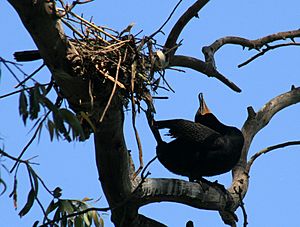
When a double-crested cormorant swims, it often keeps most of its body underwater, with only its neck and head showing. They dive from the surface, using their webbed feet to push themselves through the water. They can dive 1.5–7.5 m (4 ft 11 in – 24 ft 7 in) deep and stay underwater for 30 to 70 seconds.
After diving, you'll often see them standing with their wings spread out. They do this to dry their feathers, which are not completely waterproof. When they fly, they stay low over the water, with their bill pointing slightly upward. Sometimes, they fly in long lines from their nesting areas.
What They Eat
Double-crested cormorants find their food in the sea, freshwater lakes, and rivers. They dive underwater to catch their prey. They mainly eat fish, but they also sometimes eat amphibians and crustaceans (like crabs or shrimp).
Smaller fish can be eaten while the bird is still underwater. But if they catch a bigger fish, they often bring it to the surface before eating it. Sometimes, these cormorants are seen as a problem by fish farmers because they can eat a lot of fish from fish farms, causing losses.
Cormorants also spit up pellets that contain parts of their food they can't digest, like bones. Scientists can study these pellets to learn what the birds have been eating.
Nesting and Young
Double-crested cormorants build their nests in coastal areas, as well as near inland rivers and lakes. They make nests out of sticks in trees, on cliff edges, or on the ground on islands.
They are social birds and usually live in large groups called colonies. They often share these colonies with other water birds. When they communicate, they make a deep, gurgling sound.
Their Comeback Story
In the 1960s, the number of double-crested cormorants dropped a lot. This was mainly because of a harmful chemical called DDT. Also, sometimes people would try to reduce their numbers in areas where they thought the birds were eating too many fish that humans wanted to catch.
However, in recent years, the population of double-crested cormorants has grown significantly. One reason for this comeback is that the use of harmful chemicals like DDT was stopped. Also, the growth of fish farms in their wintering areas may have helped them survive and grow better during the colder months.
For cormorants living in the Great Lakes region, it's thought that a small fish called the alewife (which is not native to the lakes) has provided a great food source. This has helped the cormorants have many successful breeding seasons.
Because of their growing numbers, some people, especially anglers and commercial fishers, believe that cormorants are affecting fish populations. The United States Fish and Wildlife Service, which protects these birds, has allowed some government groups to manage their numbers. This can include methods to reduce their population or stop them from reproducing too much. However, regular people are not allowed to hunt them.
In 2008, the Canadian government also took steps to reduce the number of cormorant nests on Middle Island in Lake Erie. This was done to help protect the island's plants, but some people disagreed with the decision.
Images for kids
-
Ballard (Hiram M. Chittenden) Locks, (Seattle, Washington).
- Explore Species: Double-crested Cormorant at eBird (Cornell Lab of Ornithology)
See also
 In Spanish: Cormorán orejudo para niños
In Spanish: Cormorán orejudo para niños




